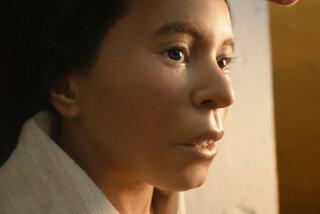Gold Treasures Found in ‘Peru King Tut’ Tomb
- Share via
WASHINGTON — Archeologists today credited looters with leading them to what they claim is the richest archeological find in the Western Hemisphere--the gold-laden tomb of “a Peruvian King Tut.”
A 2-foot-wide gold headdress, a warrior’s golden backflap weighing almost 2 pounds and a string of gold bells showing a god lopping off human heads are just a fraction of the riches found in the 1,500-year-old grave of a warrior-priest of Peru’s Mochican culture.
“The real richness is in information it contains. But in material terms, just in terms of gold objects and jewelry, this tomb contains the greatest quantity, as well as the quality, of gold jewelry that we’ve ever seen come from an archeologically excavated tomb in the Americas,” said Christopher Donnan, an anthropology professor at UCLA.
Donnan assisted the team, funded by the National Geographic Society under the direction of the Peruvian government, that excavated the tomb on the arid north coast of Peru.
Archeologists refused to give a dollar estimate for the cache of more than 100 gold, turquoise, silver and copper ornaments found at the tomb.
Police Seized Jewelry
They were alerted to the tomb’s existence in February, 1987, after Peruvian police seized some finely wrought gold jewelry that looters had dug out of a tomb buried under a massive, eroded pyramid near Sipan.
Although police raids recovered some of the booty, about 80% is believed to have been sucked up by the growing black market for pre-Columbian art.
In April, 1987, Walter Alva, director of the Bruning Archeological Museum in Lambayeque, Peru, sent a team of archeologists to the looted tomb to salvage anything the looters had left and to clean up the site.
A few months into the efforts, the archeologists noticed a depression about 30 feet from the first tomb that appeared to have been filled in with earth in ancient times. The spot was excavated and yielded a dramatic discovery--a mausoleum containing the coffin of a lavishly clad Mochican lord covered with 13 layers of valuable jewels and finely woven fabrics.
More to Read
Sign up for Essential California
The most important California stories and recommendations in your inbox every morning.
You may occasionally receive promotional content from the Los Angeles Times.













